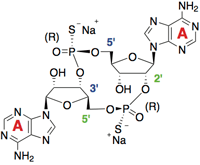2’3’-c-di-AM(PS)2 (Rp,Rp)
-
Cat.code:
tlrl-nacda2r-01
- Documents
ABOUT
Bisphosphorothioate analog of 2'3'-c-di-AMP
2’3’-c-di-AM(PS)2 (Rp,Rp) is the Rp,Rp-isomer of the 2’3’ bisphosphorothioate analog of 3’3’-cyclic adenosine monophosphate (c-di-AMP). c-di-AMP is second messenger molecule produced by bacteria with potent immunostimulant activity [1]. This cyclic dinucleotide (CDN) induces the production of type I interferons (IFNs) following its recognition by the endoplasmic reticulum-resident receptor STING (stimulator of interferon genes) and the recruitment of TBK1 (TANK-binding kinase 1) and IRF3 (interferon regulatory factor 3)[2].
Mode of action:
2’3’-c-di-AM(PS)2 (Rp,Rp) is structurally identical to ADU-S100/MIW815, a clinically-relevant molecule developed by Aduro in collaboration with Novartis currently in clinical trials for the treatment of various cancers. This analog has a higher affinity for STING than c-di-AMP due to the presence of a 2’-5’, 3’-5’ mixed linkage, as found in endogenous human CDNs produced by cGAS (cyclic GMP-AMP (cGAMP) synthase) [3].
Furthermore, it activates all known human STING alleles as well as murine STING. In addition, this analog. 2’3’-c-di-AM(PS)2 (Rp,Rp) contains two phosphorothioate diester linkages to protect it against degradation by phosphodiesterases that are present in host cells or in the systemic circulation [4]. The Rp, Rp dithio diastereoisomer has been found to induce higher type I IFN production compared to the Rp/Sp dithio diastereoisomers or c-di-AMP [3]. In vivo studies have demonstrated that 2’3’-c-di-AM(PS)2 (Rp,Rp) may potently prime tumor antigen-specific CD8+ T-cell responses and overcome antigen-enforced immune tolerance in combination with PD-L1 blockade [5].
Key Features of 2’3’-c-di-AM(PS)2(Rp,Rp):
- Potent activator of all known human STING alleles as well as murine STING
- Structurally identical to the clinically-relevant ADU-S100/MIW815
- Sterile grade available for in vivo use
- Each lot is highly pure ( >95%) and functionally validated
![]() Read our review on STING: Deciphering the STING Paradox
Read our review on STING: Deciphering the STING Paradox
References:
1. Woodward JJ. et al., 2010. c-di-AMP secreted by intracellular Listeria monocytogenes activates a host type I interferon response. Science.328(5986):1703-5.
2. Jin L. et al., 2011. MPYS is required for IFN response factor 3 activation and type I IFN production in the response of cultured phagocytes to bacterial second messengers cyclic-di-AMP and cyclic-di- GMP. J Immunol. 187(5):2595-601.
3. Corrales L et al., 2015. Direct activation of STING in the tumor microenvironment leads to potent and systemic tumor regression and immunity. Cell Rep. 11(7):1018-30.
4. Yan H. et al., 2008. Synthesis and immunostimulatory properties of the phosphorothioate analogs of cdiGMP. Bioorg. Med. Chem. Lett. 18, 5631–5634.
5. Foote JB et al., 2017. A STING Agonist Given with OX40 Receptor and PD-L1 Modulators Primes Immunity and Reduces Tumor Growth in Tolerized Mice. Cancer Immunol Res. 5(6):468-479.
All products are for research use only, and not for human or veterinary use.
SPECIFICATIONS
Specifications
C20H22N10O10P2S2 •2Na
Activation of STING validated by cellular assays
CONTENTS
Contents
-
Product:2’3’-c-di-AM(PS)2 (Rp,Rp)
-
Cat code:tlrl-nacda2r-01
-
Quantity:100 µg
1.5 ml endotoxin-free water
Shipping & Storage
- Shipping method: Room temperature
- -20°C
- Avoid repeated freeze-thaw cycles
Storage:
Caution:
Details
STING
The STimulator of INterferon Genes STING, alternatively known as MPYS, TMEM173, MITA, and ERIS, is a key sensor of cytosolic nucleic acids. Initially thought to serve solely as an adaptor protein for mediating signaling by cytosolic DNA sensors (CDS), STING was found to be a direct sensor of cyclic dinucleotides (CDNs) [1].
STING signaling
CDNs are ubiquitous second-messenger molecules in bacterial or metazoal signal transduction and are defense triggers in mammalian cells. Namely, cyclic diguanylic acid (c-di-GMP), cyclic diadenylic acid (c-di-AMP), and cyclic adenylicguanylic acid (cGAMP) are the most prevalent intracellular signaling intermediates in bacteria and/or metazoa [2-3].
A direct interaction between DNA and STING could not be demonstrated, suggesting the intervention of at least one additional protein [1]. The identity of the major dsDNA cytosolic sensor was resolved in 2013: cGAs (cyclic GMP-AMP synthase) is activated upon direct DNA binding and subsequently catalyzes the production of a non-canonical cGAMP, which in turn, activates STING [3].
Once activated, STING and TANK-binding-kinase-I (TBK1) interact to induce an active interferon regulatory factor (IRF3) dimer which then binds to interferon-stimulated responsive elements (ISRE) in the nucleus and leads to IFN-α/β production [4]. The production of NF-κB-dependent inflammatory cytokines is also observed downstream of STING activation but the underlying mechanisms remain opaque [5].
References:
1. Burdette DL. et al., 2011. STING is a direct innate immune sensor of cyclic di-GMP. Nature 478(7370):515-8.
2. Woodward JJ. et al., 2010. c-di-AMP secreted by intracellular Listeria monocytogenes activates a host type I interferon response. Science 328(5986):1703-5.
3. Wu J. et al., 2013. Cyclic GMP-AMP is an endogenous second messenger in innate immune signaling by cytosolic DNA. Science, 339(6121):826-30.
4. Ishikawa H. et al., 2009. STING regulates intracellular DNA-mediated, type I interferon-dependent innate immunity. Nature 461: 788-92.
5. Abe T. and Barber G.N., 2014. Cytosolic-DNA-Mediated, STING-Dependent Proinflammatory Gene Induction Necessitates Canonical NF-κB Activation through TBK1. Journal of Virology 88:5328-41.
Structure of 2’3’-c-di-AM(PS)2 (Rp,Rp):

DOCUMENTS
Documents
Technical Data Sheet
Validation Data Sheet
Safety Data Sheet
Certificate of analysis
Need a CoA ?


